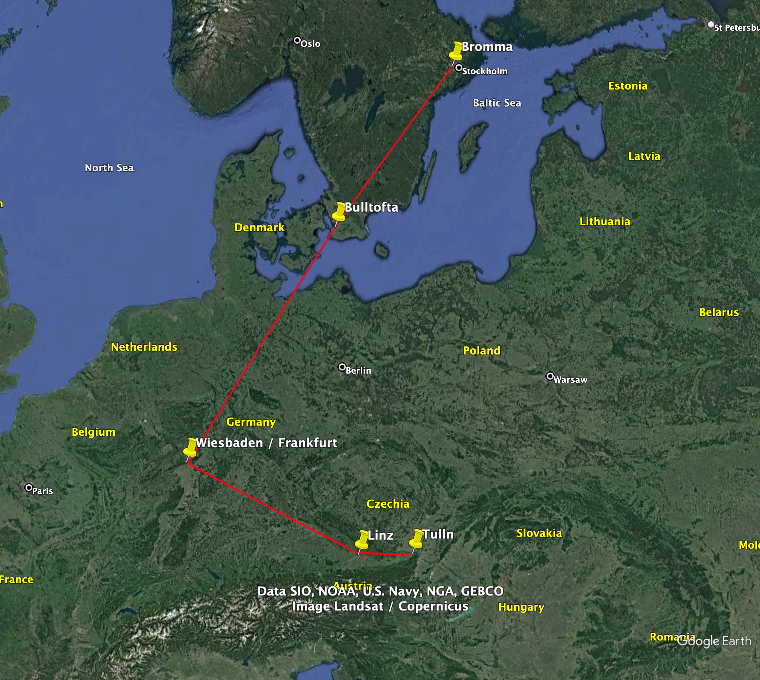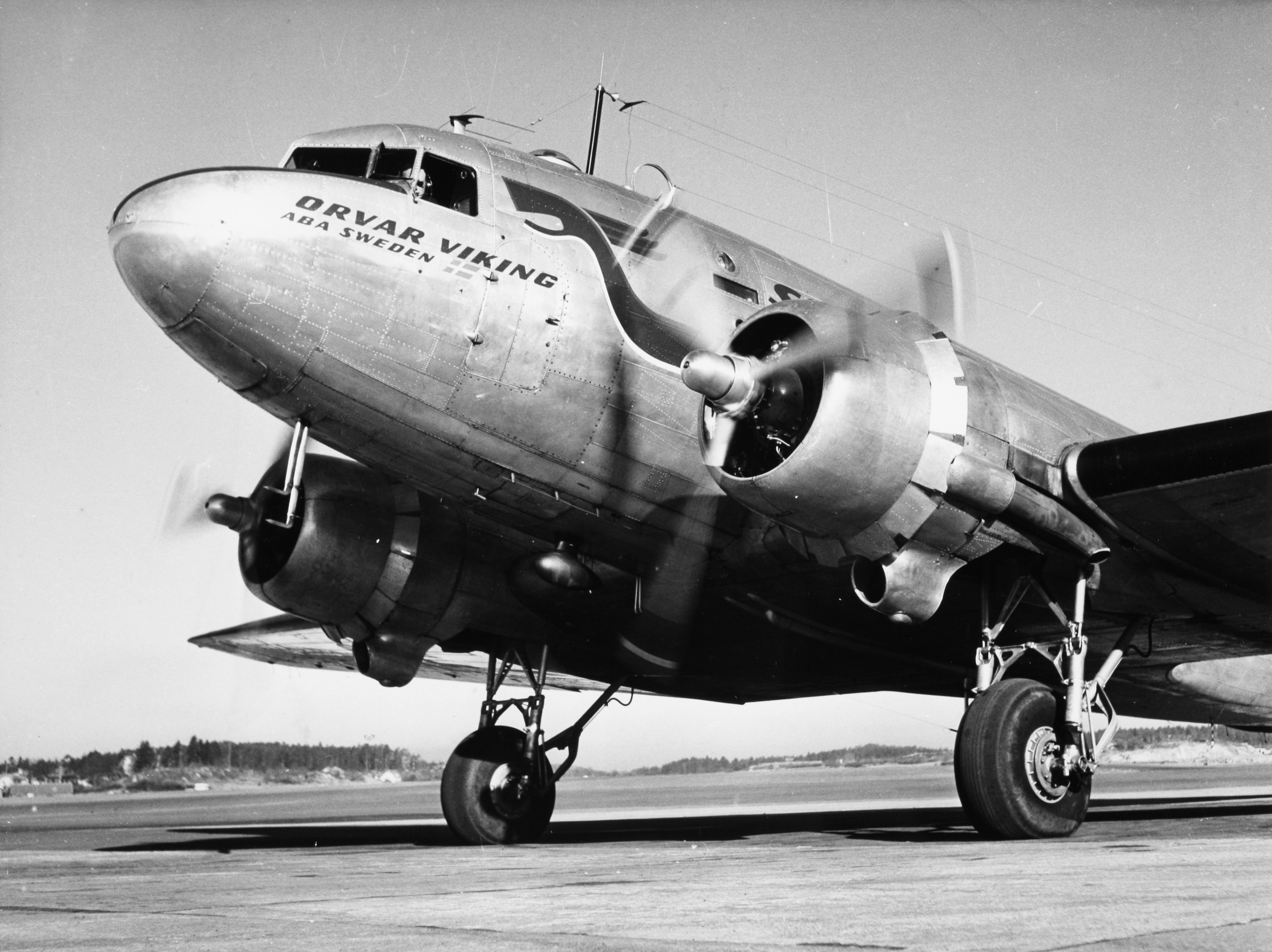After Erik von Rosen's talk about his father Carl Gustav von Rosen at SFF Stockholm’s meeting on the 26 of April, I was reminded about a flight we did together, when were were employed at ABA. The flight started on the 24th of October, 1945.
Forewords by Mattias
This is an article written by Nils Holm who served in the Swedish Air Force, ABA and later SAS. Previously published in: Svensk Flyghistorisk Tidskrift 4/05. Mattias Holm has added links and footnotes, and translated the article.
The Story
After Erik von Rosen's talk about his father Carl Gustav von Rosen at SFF Stockholm’s meeting on the 26 of April, I was reminded about a flight we did together, when were were employed at ABA. The flight started on the 24th of October, 1945.
The reason for the flight was a severe epidemic in Austria, maybe it was cholera? ABA was given the task from the Swedish government to fly down a plane (DC-3, SE-BAW) loaded with penicillin, a doctor and two or three nurses to Lintz. We were not allowed to fly all the way to Vienna as Austria to a large extent was occupied by the Russians.

It was a routine flight to Bulltofta for refuelling. Thereafter onward to Frankfurt. It was a short time after the end of the war with the problems it meant for the lack of information on airports, available mapping materials and radio frequencies (all communications was done using telegraphs).
Anyway, the weather was good and all went according to plants until we approached Frankfurt. We actually had no idea where the airfield was. Carl Gustav announced that he would himself take care of flying and instruments, (we had an indicator in the ceiling that was set to indicate the pilots responsibilities), while I got the task to keep a lookout and find the field and "Hum Hum take you if you do not find it". I was searching so that the eyes became teary and see, I found a small field just at the northern part of the city. The field was smaller than Bulltofta and only a cleared swath while the rest consisted of a lot of bomb craters. Carl Gustav expressed his surprised that the americans did not have larger airfields, but because we didn’t have any coordinates or maps of the field the telegraphist was ordered to request landing clearance. We got it and managed to stay in the short field which turned to be a spot for hundreds (?) of Piper Cubs - but no other airplanes.
We caused a lot of excitement, partly due to our nationality and partly because no airplane as large as a DC-3 had visited the field before. We were informed that we were probably supposed to fly to Wiesbaden, that was about eight minutes flying time to the southwest. It was not hard to find, a gigantic field with an asphalt runway, lots of large planes ang good service.

After refueling we flow onwards to Lintz, that was our final desintation, we arrived there without problems. The head of the airport, a colonel, checked our papers. Because the load was destined to Vienna, he suggested that we continue to an airport named Tulln. We explained that we had been told not to fly further than Lintz because we would fly over the Russian zone.
Well, that was probably right, but the allied had an air corridor that was ok to fly in. We were given a map where the corridor was drawn and departed. Only the city of Lintz [1], but not the airfield was on the map and it started to get dark when we approached the field. Carl Gustav ordered me to find the field and again threatened with Hum-Hum if I failed. I swa the lights from the city and the surrounding villages. No lightning for aircraft was visible, but there was an area that was completely dark and I assumed it was an airfield which I told. We circled around the field, got radio contact (on frequency 6440?) and within time a the row of goosenecks was lit up in the direction of the landing so we could land in complete darkness.
If we hade gotten attention in Frankfurt, that was nothing to this reception. We were informed that we had severely ignored existing flying restrictions. The corridor was only to be flown by allied military aircraft and even if it was not directly stated, we almost felt that we were threatened win internment: any return flight was at the time not thinkable. We were however well met and was invited to the officers mess for dinner. After a lot of parlaying, the colonel had the brilliant idea that we would receive a fighter escort to Lintz the following morning. Everyone was convinced that the Russians had informants that was leaking our presence.
When we on the 26th were ready for takeoff, we were informed that the headquarters in Wiesbaden had decided that we would have to do without escort because they didn’t want to disturb the good relations with the Russians. "If they have entered illegally they have to face the consequences and make it out themselves." We did a normal takeoff and turned west. As soon as we had taken up the gear and flaps I was ordered up to the astrodome (sometimes we navigated after the stars) to keep a good lookout, because they had almost guaranteed that the Russians would show up. The cloud layer was 700 m and we flew closely under the clouds and it was not long until two two-ship formations of MiG-5 [2] approach from the north. It was the first time i saw a two-ship formation, in Sweden we were still using three-ship formations.
When i informed about my observation I got back to my pilots seat. Carl Gustav gave full throttle and turned steeply away from the Russians and we disappeared in the clouds and was thus no longer visible for the Russians. Well among the clouds, a right turn towards the Russians was done and soon, we were able to get back to the corridor - of-course in clouds until we were in Germany. The flight was then routine until we were back at Bromma and it resulted in 3872 km flying under 14 h 43 minutes in the air.
|
Note
|
MiG-5 was actually a development of the MiG-3 and the only MiG-type with a star motor, a Shvetsov M.82 A with 1600 hp instead of the MiG-3:s in-line engine Mikulin AM 35A with 1350 hp. Neither the MiG-3 nor the MiG-5 achieved their expectations and MiG-5 was at the time of our flight not used in Russia. Our antagonists were probably based in Czechoslovakia, near Prague. At another time one of ABA's converted flying fortresses was shot at during a flight from Prague. The damage was limited to a few bullet holes. |
